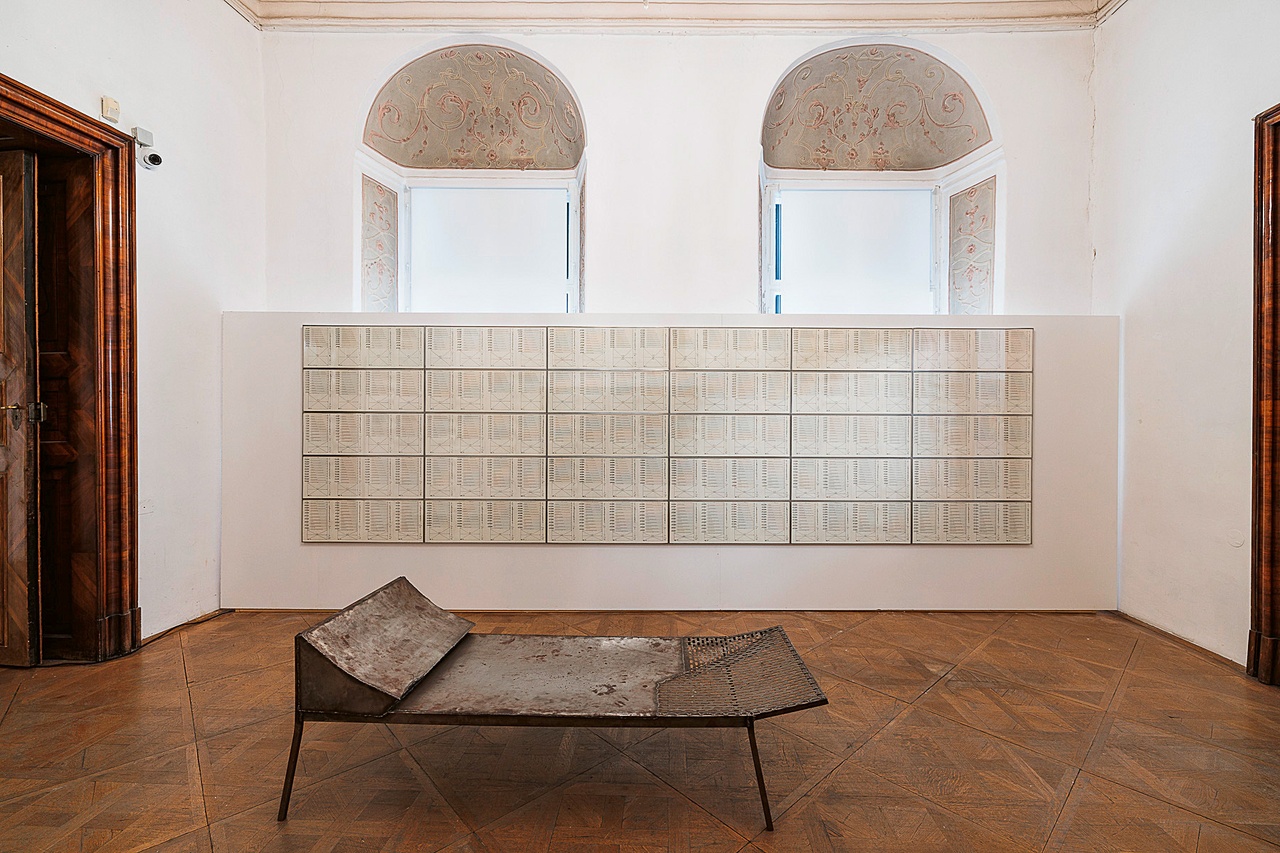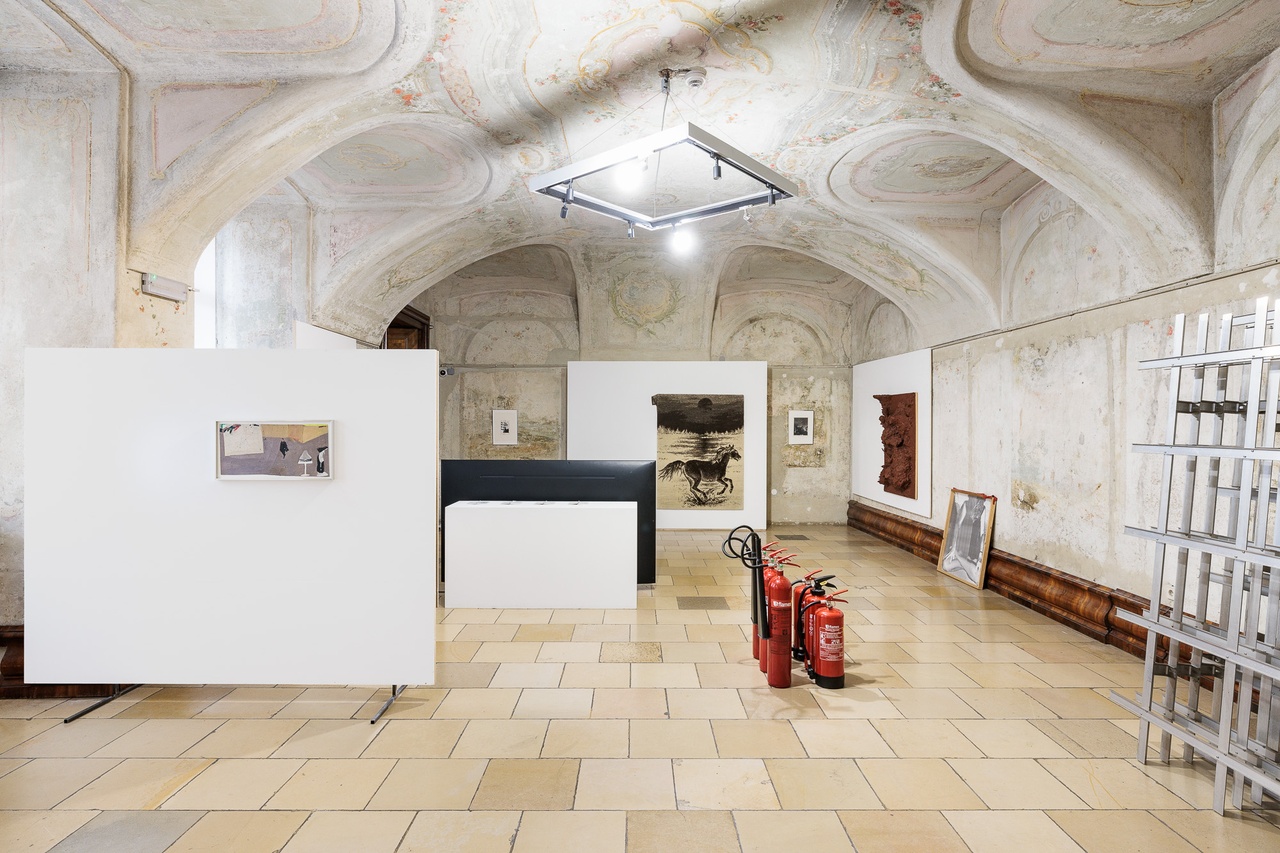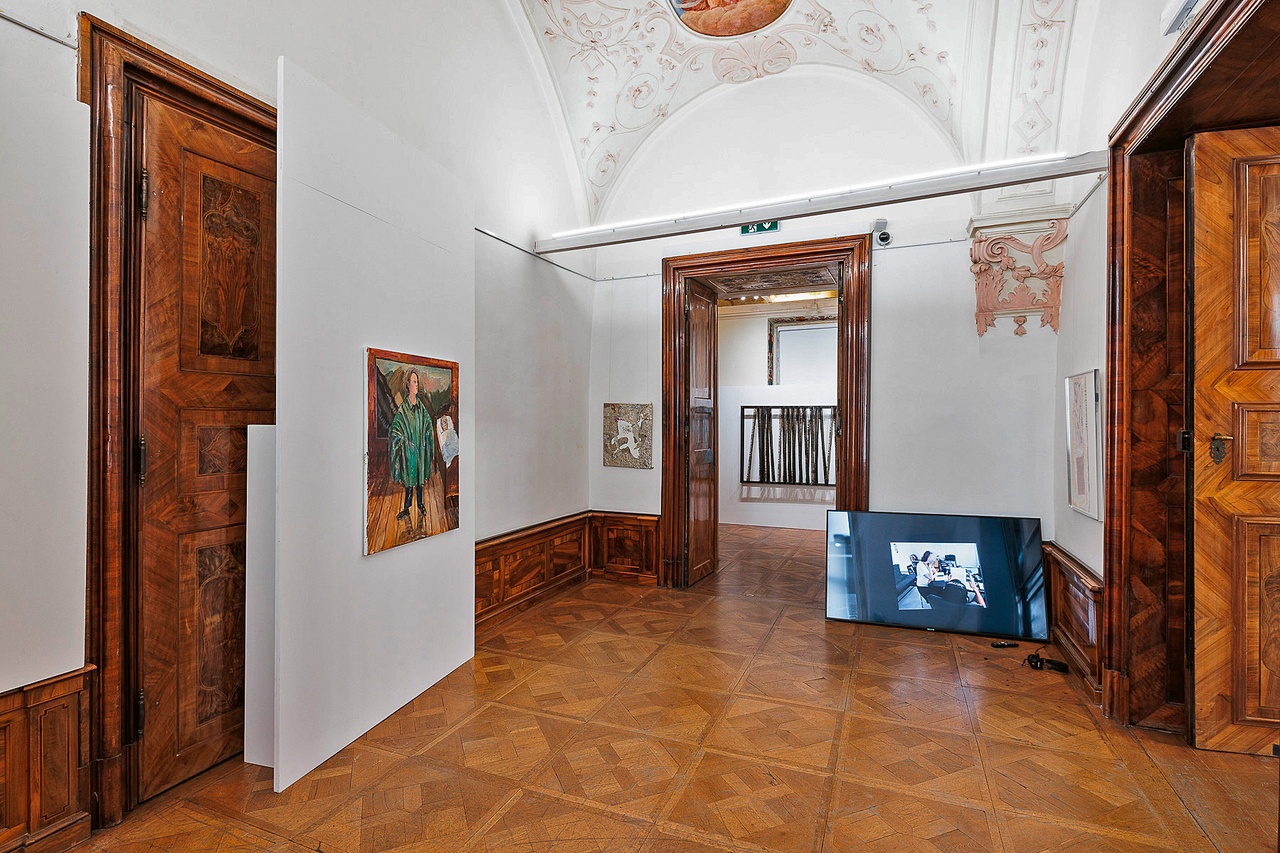DROWNING IN ONE’S OWN BELLY BUTTON Miriam Stoney on “Ins Dunkle schwimmen: Abysses of the Creative Imperative” at the University Gallery of the Angewandte in Heiligenkreuzerhof, Vienna

“Ins Dunkle schwimmen: Abysses of the Creative Imperative,” University Gallery of the Angewandte in Heiligenkreuzerhof, Vienna, 2024–25
Creativity has always occupied a dubious position in the history of philosophy. From Plato’s denunciations of art as mere mimesis to today’s neoliberal conceit of productive self-realization, creativity has long been a byword of hubris. Historically and philosophically speaking, artists have been assumed to have a monopoly on creative output, continually redefining the scope of possibility in the pursuit of that which does not exist. This is perhaps why artists are, supposedly, doomed to suffer.
The cult of the artist as a troubled genius first came under the critique of feminist theorists in the 1970s, such as Linda Nochlin, who saw “greatness” as a correlate of phallic ideals in art. By attending solely to specific identities – usually those of straight white men – this critique is easily sidestepped by the more diffuse and diverse processes of subjectivation in operation today. When concepts such as creativity are taken to be constitutive of subjectivity, as in the self-making of the supposedly independent artist, it becomes harder to recognize human capital being instrumentalized to create a product, the self, to which we may have no direct relation.
Extreme alienation thus threatens to become the modus operandi of artists, the quintessential creative subjects, working today. This is a standpoint that requires reorientating in an economy of disparate creative industries. From the fashioning and marketing of the self, to the structural precarity of the profession, even down to the extraction of the autobiographical to produce and sell work, artists as “creatives” are presumed to work most effectively with things they don’t have – a fixed status, material means, or capital. So, if artists were to forego creativity altogether, what would that leave them to work with? This is the question I was left pondering after seeing the group exhibition “Ins Dunkle schwimmen: Abysses of the Creative Imperative” at the University Gallery of the Angewandte (University of Applied Arts) in Heiligenkreuzerhof, Vienna, curated by Cosima Rainer and Robert Müller.
This exhibition takes place in a baroque building of the Heiligenkreuzerhof, the rooms decked out with varnished wood paneling and the temporary exhibition architecture cobbled together out of basic metal structures and MDF boards. The focus is on the works, and there are many treasures in the exhibition to overshadow the provisional, almost slapdash nature of the display: Lee Lozano, Franz West, Harun Farocki, and Hanne Darboven meet and complement works by younger artists such as Luzie Meyer, Min Yoon, Verena Dengler, and Jana Euler.
There is a stark focus on sculptural and installation works, with rooms bordering on overcrowded, though in the vein of “The more the merrier.” And the Viennese crowd is very merry indeed: the show has generated a wave of enthusiasm almost unprecedented during my time in the city. The ostensible subject here is the artist. At a time of out-and-out political turmoil in Austria, the ideological collapse of art institutions in neighboring countries, and the ongoing and ever-present horrors of war around the world, this inward regard finds neat parallels within the discourse of a Viennese art world that struggles to address current affairs and potentially divisive issues in both everyday conversations and more public statements.

“Ins Dunkle schwimmen: Abysses of the Creative Imperative,” University Gallery of the Angewandte in Heiligenkreuzerhof, Vienna, 2024–25
The notion of foregoing creativity finds its most provocative riposte in works that make use of banality and blandness. The artist asserts their troubled existence as a harmless human, worker, or citizen – but behind this assertion, the work is a claim to a special status, in opposition to mere hubris. Hanne Darboven’s Ein Jahrhundert I B (1973) is a case in point: the rows of handwritten numbers show digit sums of dates to create a broadly applicable system for centuries past, present, and future. As an operative reference within art history, the century is thus collapsed into one single, though expansive work, and the artist presides over these durations with methodical confidence. It is the personal, aesthetically specific quality of Darboven’s handwriting that frames this generalized representation. The century becomes a system, a grid, a form for the artist to fill in. On the wall facing this work is a painting from the series Camera 4 (Lumix) (2021) by Jana Euler. An enormous camera lens focuses on Darboven’s endeavor to arrange time, thus witnessing and documenting, though also monitoring, the artist at work. This arrangement is pivotal to the exhibition: as a dialectic between the artist’s (seemingly) unselfconscious and non-teleological action, on the one hand, and the gaze that renders this a process of self-making, on the other. It also pinpoints two distinct notions of alienation, marked by artists of two different generations: the structuralist belief in conceptual, disciplinary systems and a subsequent recognition of the total dispersion of arbitrary power through poststructuralism.
The moment prior to creativity, just before the artist produces their commodity, when action is not yet (self-)making, signals a potential that is meant to go unrealized. Lee Lozano’s Masturbation Investigation, Party Piece (or Paranoia Piece), and Party Piece, Companion Piece (all 1969) are framed, handwritten notes on graph paper, which read like cynical schemes against the art world: “DESCRIBE YOUR CURRENT WORK TO A FAMOUS BUT FAILING ARTIST FROM THE EARLY 60’S. WAIT TO SEE WHETHER HE BOOSTS ANY OF YOUR IDEAS. (MARCH 15, 69) HOIST, COP, STEAL.” Placed at intervals throughout the exhibition, they undermine the notion of artwork and its display.
Similarly, Ghislaine Leung’s work Holdings (2024) is defined by a so-called score, which determines what material form the exhibited work should take. Leung shows a similar suspicion of art as an institutional enterprise with a score that demands “An object that is no longer an artwork.” Here, the temporality is reversed to signal a desire to make the artwork obsolete. The score’s interpretation at Heiligenkreuzerhof consists of six fire extinguishers, three each of two different kinds, standing like a choir at the entrance to the exhibition, regarding Josef Dabernig’s Ohne Titel (1992). This is the artwork proper, a modernist grid of steel bars arranged as a silent complement to the film Hypercrisis (2011). Indeed, the video works in the exhibition attempt to fill the gaps in content where the sculptural objects and wall works eschew direct reference to anything beyond themselves.
The moving image’s seeming capacity for mimicking reality makes it a medium that is ripe for working through the material realities of issues as knotty as those this exhibition, according to the press release, seeks to address – namely, the “dialectic of creative self-optimization, self-care, and self-exploitation.”

“Ins Dunkle schwimmen: Abysses of the Creative Imperative,” University Gallery of the Angewandte in Heiligenkreuzerhof, Vienna, 2024–25
Two works, one displayed in the very first room and the other in one of the last, span the breadth of commentary within the show. Jean-Marie Straub’s La France contre les robots (2020) shows a man walking and reading out loud a passage from a text of the same name. It was written by Georges Bernanos in the 1940s, and the man recites it twice, at different times of the day. The text formulates the necessity of a social revolution in order to overthrow the capitalist system, which engages technology as a means of domination. The repetition, with the implied passage of time, makes of its stirring affect a sad refrain.
Luzie Meyer’s video Incognito ergo non sum (2024) is positioned to perform part of the exhibition’s climactic finale. Its soundtrack takes repetition as a means to generate a rhythmic intensity that potentiates the language of the two speaking characters. In the uncanny relation to marketing speech and self-improvement discourses, the reciprocal questioning and self-justification of the two figures generate an excess of language that still fails to equate to a workable identity or subject: “I wish there were more of myself,” says one character. The centripetal spiral this creates is the reverse of Straub’s supernova-vision-gone-cold; it is the implosion of language n a world running on action, a black hole of content made inscrutable through the unstoppable accretion of words.
Perhaps repetition compulsion is the answer to my earlier question about what artists have to work with once creativity falls by the wayside. Seriality and accumulation feature heavily in the exhibition as a way of generating, reinforcing, and ultimately emptying out meaning through a single impulse, repeated: in addition to the works already mentioned, Tonio Kröner’s stuffed, furry figures (re)appear in different rooms and Franz West’s two divan-style furniture sculptures, in their doubling, point back to psychoanalysis as a recursive practice. The psychoanalytic patient’s repetition of patterns of distressing behavior serves as the primary focus of the therapeutic treatment to this day, and it is through repeated telling that healing is thought to take place. In the exhibition’s weave of repetition, artists submit and are submitted to forms of analysis that both witness and encourage the compulsive aspects of art-making. Which begs the question: Is the abyss of the creative impulse a concoction of this very exhibition? The question is a tentative one, not least because the abyss is difficult to locate in any of the works, their display, or the exhibition’s narrative. The exhibition text states, “Ins Dunkle schwimmen" [Swimming into the Dark] refers less to an ominous unknown but rather to the deep waters, dangerous currents, and at times dark abysses of self-doubt and perceived inadequacy that are closely associated with creativity.” The exhibition frames the works as responsive to “ecological, social and political crises” but does so only in terms of artistic subjectivation, leaving the implication as simply that. The ominous unknown would be a preferable framing device, since what is missing from this exhibition is precisely the incognizable complexities of the real world, where the artist’s existence is now becoming more and more precarious and even politically dangerous. Anywhere but Vienna, this would be considered a somewhat naive exhibition of artists’ artists: a navel-gazing rumination on creativity that has proved highly seductive to an audience of art students and academy-adjacent visitors who, one might assume, look to the University Gallery as a further pedagogical space.
The lesson here is amateur psychology, and we pupils are to engage with art as the continual reproduction of a very specific subjectivity that would rather bear no relation to anything other than itself. Works such as Luzie Meyer’s knowingly hint at the impasse this invokes, though there is little opportunity within the show to go beyond the artist’s subject status, albeit or especially when this very status is brought into question through the banality of everyday life, the precarity of the work, or a dwindling dream of radical social transformation. This is not a mythologization nor a mystification per se, but an example of art’s self-fulfilling prophesy, the modernist dream of being inapplicable, for fear of being applied to some other purpose. Hence, artists are shown toiling most diligently to divest themselves of responsibility for their products – a social constructivist and fatalist stance that is most easily maintained when creativity is written off as a folly.
“Ins Dunkle schwimmen: Abysses of the Creative Imperative,” University Gallery of the Angewandte in Heiligenkreuzerhof, Vienna, October 16, 2024–February 1, 2025.
Miriam Stoney is a writer, artist, and translator based in Vienna.
Image credit: © Kunstsammlung und Archiv, Universität für angewandte Kunst Wien, photos Manuel Carreon Lopez

